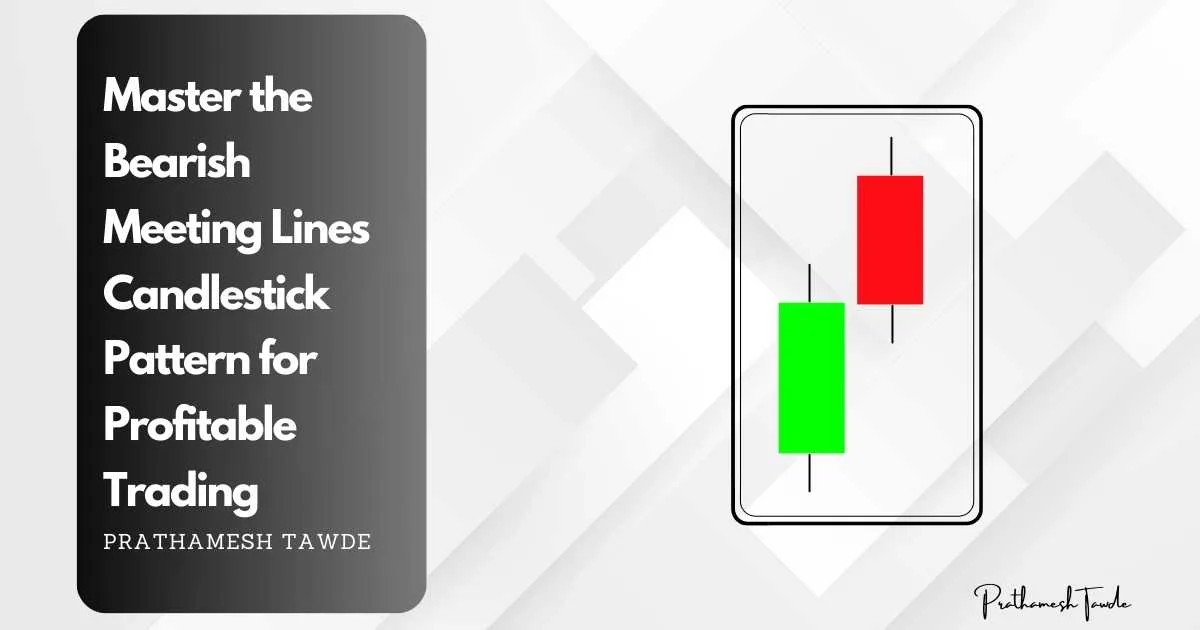Master the Bearish Meeting Lines Candlestick Pattern for Profitable Trading
- Prathamesh Tawde
- May 17, 2024
Understanding of Bearish Meeting Lines Candlestick Pattern
Definition
The Bearish Meeting Lines pattern is a two-candlestick reversal. It appears at the end of an uptrend. It signals a potential shift from bullish to bearish sentiment in the market.
Characteristics of pattern
This pattern consists of two candles: the first is a bullish candle, and the second is a bearish candle. Both candles have the same closing price. This shows a stalemate between buyers and sellers. The pattern’s appearance suggests that the upward momentum weakens. A downward trend may follow.
Historical Context and Origins
The Bearish Meeting Lines pattern comes from Japanese rice trading. It, like many candlestick patterns, has its origins there. The design aimed to understand the psychology of market participants. It predicts future prices using historical data.
How to Identify patterns
Key Components of the Pattern
The first candlestick is bullish, showing the continuation of the current uptrend.
The second candlestick is bearish, closing at the same level as the first candlestick.
The closing prices of both candles are the same or very close.

Step-by-Step Identification Process
Identify an existing uptrend in the market.
Look for a bullish candlestick that supports the uptrend.
Check for the following bearish candlestick that closes at or near the same price as the first.
Confirm the pattern with other technical indicators.
Common Mistakes in Identification
Misinterpreting other similar patterns, such as the Bearish Engulfing pattern.
Ignoring the overall trend direction before the pattern formation.
Overlooking the need for confirmation from other technical indicators.
Psychology Behind pattern
Market sentiment indicated by the pattern.
The Bearish Meeting Lines pattern reflects a shift in market sentiment. At first, buyers dominate, pushing prices higher. But a bearish candle emerged at the same closing price. It signals that sellers are gaining strength and a potential reversal.
Trader Behavior and Reactions
Traders observing this pattern may see it as a sign to take profits from their long positions. Or, they may consider entering short ones. The pattern suggests caution, as the uptrend’s strength is waning.
candlestick in charts
Chartink.com Overview
Chartink.com is an online stock screener and charting tool. It lets traders scan for technical patterns and analyze market trends. Chartink.com has customizable filters and an easy interface. It’s a great resource for traders.
Below is the screenshot of how the websibsite looks , You can simply

You can search for Bearish Meeting Lines screeners. It will show you all stock charts with a hammer pattern.
Keep in Mind, Some bearish meeting line patterns are wrong and won’t give the right signal. We will only use screeners to find likely bearish meeting line patterns.
Daily Charts
On daily charts, the Bearish Meeting Lines pattern can state short-term reversals. Traders should track the following candles for confirmation before making trading decisions.
Weekly and Monthly Charts
The pattern appears on weekly or monthly charts. It may signal big, long-term trend reversals. Traders should be patient and seek confirmation from other technical indicators and patterns.
Practical Trading Strategies
Entry and Exit Points
Enter a short position. Do this after you confirm the bearish meeting lines pattern with other indicators.
Exit: Set a target price based on previous support levels or use a trailing stop to lock in profits.
Risk Management and Stop-Loss Placement
Effective risk management is essential when trading the bearish meeting lines pattern. Place a stop loss above the second candlestick’s high. This will limit potential losses if the market does not reverse as expected.
Case Studies and Examples
Imagine a scenario. The Bearish Meeting Lines form at the peak of a long uptrend. Historical data may show similar patterns. These patterns lead to big reversals, giving traders practical examples to study.
Common Pitfalls and How to Avoid Them
Misinterpretation of the pattern
Traders often mistake other patterns for bearish meeting lines. It’s vital to ensure that both candles have nearly the same closing price and appear at the end of an uptrend.
Over-Reliance on Single Indicators
Relying only on the bearish meeting lines pattern can lead to false signals. You need more confirmation. Always use complementary indicators to confirm the pattern.
bearish meeting lines vs Bullish Meeting Lines
- Occurs at the end of an uptrend.
- The first candle is bullish.
- The second candle is bearish and closes at the same level as the first candle.
- Signals a potential shift from bullish to bearish sentiment.
- Occurs at the end of a downtrend.
- The first candle is bearish.
- The second candle is bullish and closes at the same level as the first candle.
- Signals a potential shift from bearish to bullish sentiment.

Conclusion
The Bearish Meeting Lines is a valuable tool for traders. It helps them spot possible market reversals. Traders can incorporate this pattern into their strategies. They can understand its parts, psychology, and practical uses. But it’s crucial to confirm the pattern with other indicators. Also, manage risk well to maximize success.
FAQs
A Bearish Meeting Lines pattern is a candlestick pattern that signals a potential bearish reversal. It consists of a bullish candle followed by a bearish candle, with both candles closing at or near the same price level.
No, the pattern is a reversal pattern. It appears at the end of an uptrend.
The Bearish Meeting Lines pattern means the bulls had control. They pushed the price higher. But, the bears took over and pushed the price back down to the previous close. This indicates a shift in momentum and a potential reversal from an uptrend to a downtrend.
Many traders consider the Bearish Meeting Lines pattern. They see it as a somewhat reliable bearish signal. Its reliability increases when confirmed by other technical indicators. These include a drop in trading volume. Also, bearish divergence in momentum indicators. Or, bearish price action that follows.
Traders often make these mistakes. They enter trades without extra bearish price action confirmation. They ignore the broader market context and don’t use stop-loss orders. It’s important to wait for confirmation and use proper risk management techniques.





